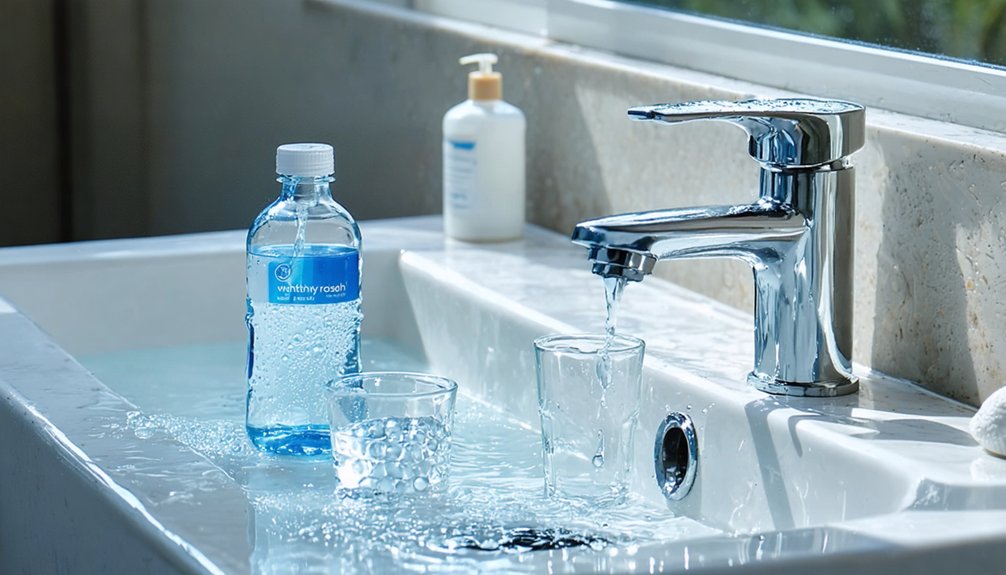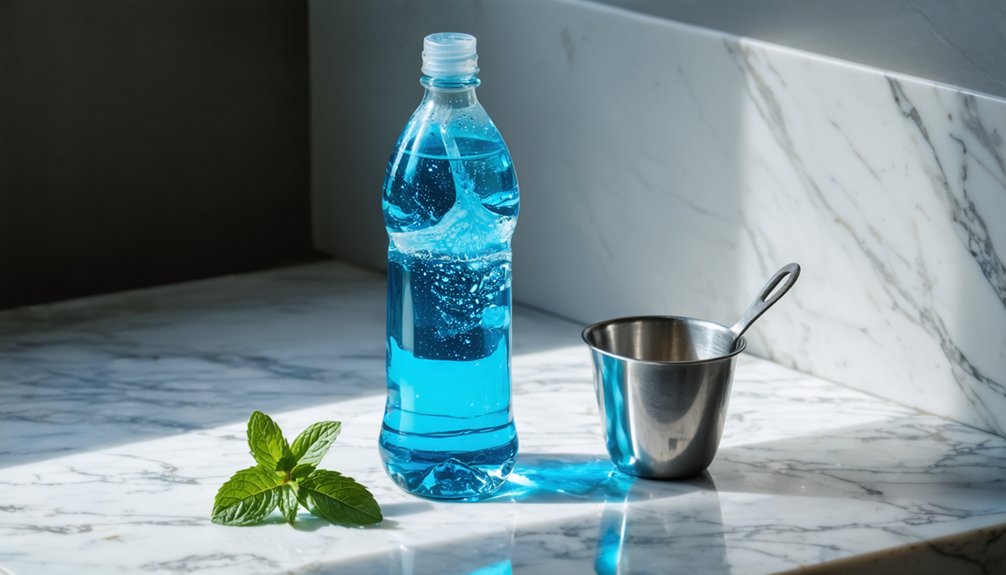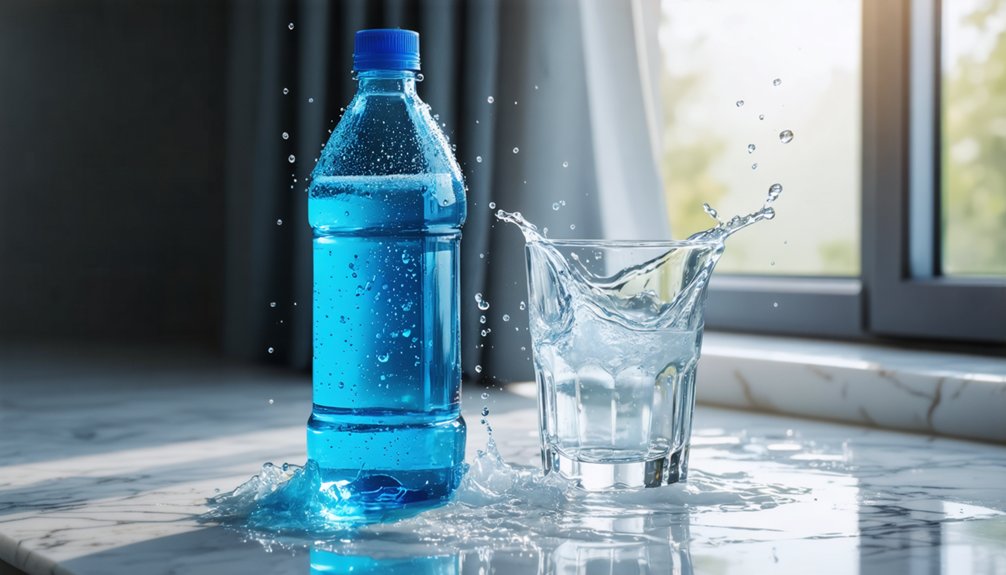You’ll find effective whitening mouth rinses containing 1.5-2% hydrogen peroxide to combat both extrinsic and intrinsic tooth stains. Top-rated options include Colgate Optic White for rapid results, ACT Whitening Anticavity for daily maintenance, and TheraBreath Whitening Fresh Breath for dual-action benefits. For best results, swish 10-15mL twice daily for 60 seconds after brushing, and wait 30 minutes before eating or drinking. Understanding the science behind these products can help maximize your whitening success.
Key Takeaways
- Colgate Optic White contains high hydrogen peroxide concentration, delivering visible teeth whitening results within days of regular use.
- ACT Whitening Anticavity provides dual benefits of cavity protection and stain removal through its fluoride-enhanced whitening formula.
- For optimal results, use whitening rinses containing 1.5-2% hydrogen peroxide twice daily for 60 seconds after brushing.
- Products with sodium hexametaphosphate prevent new stain formation while actively removing existing discoloration from teeth surfaces.
- Consistent use of peroxide-based whitening rinses for 8-12 weeks is necessary to achieve noticeable tooth whitening results.
Understanding Teeth Discoloration and Its Causes
The complex nature of tooth discoloration encompasses multiple types and causes that can affect your dental health.
Poor dental hygiene can lead to plaque buildup, contributing to unsightly stains on teeth surfaces.
You’ll encounter two primary categories: extrinsic factors, which affect the tooth’s surface, and intrinsic factors, which originate from within the tooth structure.
Extrinsic factors include daily habits like consuming staining foods, tobacco use, and inadequate oral hygiene.
In contrast, intrinsic factors stem from deeper issues such as pulpal necrosis, medication effects, or congenital conditions. Certain medications, particularly tetracycline antibiotics, have been widely documented to cause significant tooth discoloration. Age-related changes and dental trauma can also contribute to discoloration through internal tooth alterations.
Studies indicate that about 9.8% of people report tooth discoloration, affecting individuals across different age groups.
Understanding these distinctions is essential, as they’ll determine the most effective treatment approach for your specific case.
How Whitening Mouth Rinses Actually Work
Your whitening mouth rinse works through hydrogen peroxide’s oxidation process, which breaks down stain molecules into colorless compounds as the solution penetrates your tooth enamel.
Most whitening rinses contain 1.5-2% hydrogen peroxide to safely lift surface stains while minimizing sensitivity.
You’ll need to use the rinse consistently for 8-12 weeks since the brief 60-second contact time requires repeated exposure to achieve noticeable results.
While the peroxide actively bleaches stains, additional ingredients like polyphosphates help prevent new stains from forming on your teeth’s surface during daily use.
The rinse penetrates through your enamel acting as a semipermeable membrane to allow the whitening gel to reach deeper stains.
Chemical Bleaching Process Explained
While teeth whitening may seem mysterious, understanding the chemical bleaching process reveals how mouth rinses achieve their whitening effects. The process relies on peroxide-based agents, primarily hydrogen peroxide or carbamide peroxide, which trigger chemical reactions when they contact your teeth.
These compounds break down into free radicals that target and fragment stain molecules through oxidation. Professional treatments can utilize light activation technology to accelerate this process. External stains from coffee, tea, and wine are typically the first to respond to whitening agents.
The whitening efficacy depends on several key factors: the concentration of peroxide used, the pH level of the solution, and the duration of contact with your teeth.
Your enamel’s permeability also plays an essential role, as the whitening agents must penetrate to reach the dentin layer where many stains reside. For ideal results, whitening mouth rinses typically maintain a slightly alkaline pH, which enhances the peroxide’s ability to break down stains effectively.
Daily Stain Prevention Methods
Understanding how whitening mouth rinses prevent daily stains begins with recognizing two distinct types of tooth discoloration: extrinsic and intrinsic stains.
As part of your daily oral hygiene, whitening rinses work primarily through peroxide-based ingredients that target surface (extrinsic) stains. The proximity to stains determines how effectively these rinses can oxidize discolored compounds. When you use these rinses for 30-60 seconds twice daily, the peroxide diffuses to your tooth surface and chemically alters chromogens through oxidation, making them less visible. Using an alcohol-free formula ensures a comfortable experience without the burning sensation common in traditional mouthwashes.
While they’re effective for stain prevention, they don’t physically remove existing stains like brushing does.
For best results, you’ll need consistent use over 3 months to achieve 1-2 shades of improvement. While this is slower than professional treatments, it’s an effective maintenance strategy when combined with proper brushing and good dietary habits.
Active Ingredient Roles Breakdown
Two primary active ingredients power the whitening action in mouth rinses: hydrogen peroxide and carbamide peroxide.
These active ingredients work through an oxidation process that breaks down stain molecules within your tooth enamel. When you use products like Colgate Luminous White or Listerine Whitening Extreme, their peroxide concentrations typically range from 2-2.5%. Many whitening rinses now offer alcohol-free solvents as alternatives for sensitive patients. Recent research shows that extrinsic stains can be effectively reduced using both carbamide and hydrogen peroxide formulations over set durations.
- Hydrogen peroxide directly penetrates enamel to target stains
- Carbamide peroxide releases hydrogen peroxide gradually for sustained action
- Free radicals from peroxide decomposition break down complex stain molecules
- Product formulations include preservatives and fluoride for enhanced benefits
- Whitening efficacy depends on consistent use and proper concentration levels
Understanding these mechanisms helps you make informed choices about whitening products while considering safety considerations for your patients’ unique needs.
Top-Rated Products in the Market Today
When comparing top whitening mouth rinses, you’ll find significant differences in both technology and pricing across popular brands like Popwhite Smile, Crest 3D White Brilliance, and Moon Platinum.
While peroxide-based formulas like Crest and Colgate typically offer gradual results at a lower price point, premium options like Popwhite Smile command higher prices for their specialized technologies and gentler formulations.
Your choice ultimately depends on weighing factors such as sensitivity concerns, immediate versus gradual results, and whether you’re willing to pay more for natural ingredients and specialized whitening technologies.
Popular Brand Comparisons
As consumers navigate the extensive selection of whitening mouth rinses, several brands consistently rank at the top for their efficacy and specialized formulations.
Brand effectiveness and consumer preferences highlight distinct advantages across leading products, helping you make informed choices for your oral care needs.
- Crest 3D White Brilliance leads the market with its powerful peroxide formula, delivering proven stain removal while protecting enamel.
- Colgate Optic White offers high hydrogen peroxide concentration, showing visible results within days of regular use.
- ACT Whitening Anticavity combines fluoride protection with whitening action, ideal for daily maintenance.
- Listerine Healthy White Vibrant provides thorough care through whitening and cavity prevention.
- TheraBreath Whitening Fresh Breath stands out for dual-action whitening and extended breath freshening benefits.
Price Vs Performance Analysis
While budget-friendly whitening mouth rinses offer basic stain removal between $5-10, premium products priced at $20-30 deliver enhanced whitening power through advanced technologies and specialized ingredients.
In your price effectiveness evaluation, you’ll find mid-range options ($10-20) strike a balance between cost and results. Products like Moon Oral Care’s Platinum Whitening Mouth Rinse demonstrate strong performance metrics, with users reporting visible results within days.
Performance evaluation data shows that innovative formulations, such as Popwhite Smile’s POP technology, can achieve up to four shade improvements without peroxide, justifying their higher price point.
When considering value, subscription services can reduce long-term costs while maintaining consistent results. Natural ingredient-based products may command premium prices but offer additional benefits for those seeking gentler whitening solutions.
Key Ingredients to Look for in Whitening Rinses

What makes whitening mouth rinses effective? The active ingredients determine their performance and align with consumer preferences for both safety and results.
You’ll want to focus on products containing scientifically proven compounds that target stains while protecting your enamel.
- Hydrogen peroxide or carbamide peroxide for deep stain oxidation and gradual whitening
- Sodium fluoride to strengthen enamel during the whitening process
- Sodium hexametaphosphate for preventing new stains from forming
- Alcohol-free solvents like glycerin to maintain stability without irritation
- Xylitol or other non-cariogenic sweeteners for improved compliance and cavity protection
These ingredients work synergistically to deliver peak results.
Look for products that combine peroxide-based whitening agents with protective compounds to guarantee you’re getting effective whitening while maintaining oral health.
Benefits Beyond Just Teeth Whitening
Though whitening mouth rinses are primarily marketed for their stain-fighting abilities, they offer numerous additional benefits that support thorough oral health.
While commonly known for teeth whitening, these specialized rinses deliver multiple oral health advantages beyond cosmetic enhancement.
You’ll notice significant improvements in gum health as hydrogen peroxide reduces inflammation and fights bacteria that cause periodontal diseases. These rinses effectively combat plaque formation, decreasing it by over 26% while reducing gingivitis by more than 20%.
Beyond dental benefits, you’ll experience superior breath control as these rinses eliminate odor-causing bacteria rather than merely masking bad breath.
They’re particularly effective at removing food particles and addressing halitosis at its source. When combined with regular brushing and flossing, whitening rinses provide extensive protection by reaching areas your toothbrush might miss, especially along the gumline and between teeth.
Best Practices for Using Whitening Mouth Rinses

To achieve ideal results with whitening mouth rinses, you’ll need to follow specific dosage and timing guidelines. The proper mouthwash timing and rinsing techniques are essential for maximum whitening effectiveness and safety. Focus on these important practices:
- Use 10-15 mL (2-3 teaspoons) for whitening rinses, swishing thoroughly for 60 seconds or as directed.
- Rinse twice daily after brushing and flossing, avoiding water dilution to maintain product strength.
- Wait at least 30 minutes before eating or drinking to allow whitening agents to work effectively.
- Follow age restrictions, using only if you’re 12 years or older, unless supervised by a dental professional.
- Combine with whitening toothpaste after brushing to enhance stain removal, but avoid overuse that might cause sensitivity.
Expert Tips for Long-Lasting Results
Since maintaining a bright smile requires ongoing care, implementing specific lifestyle habits and oral hygiene practices can greatly extend your whitening results. Unlike common whitening myths suggesting quick fixes, long-lasting results depend on consistent hydration and preventive measures.
You’ll achieve superior outcomes by rinsing your mouth with water for 10-15 seconds after meals and using sugar-free gum when water isn’t available.
While various home remedies claim effectiveness, focus on evidence-based practices: use a straw for staining beverages, choose lighter-colored foods, and maintain thorough oral hygiene with fluoride toothpaste and daily flossing.
Combine these habits with professional dental cleanings and appropriate whitening products like mouth rinses containing 1.5-2% hydrogen peroxide. You’ll help your patients maintain their bright smiles by emphasizing these proven maintenance strategies.
Frequently Asked Questions
Can Whitening Mouthwash Make Teeth Sensitive During Orthodontic Treatment?
Yes, you’ll likely experience sensitivity issues when using whitening mouthwash during orthodontic care, as peroxide agents increase tooth porosity and can irritate nerve endings beneath your braces or aligners.
Will Whitening Mouthwash Affect the Color of Dental Crowns or Veneers?
Like your coffee-stained natural teeth, whitening mouthwash won’t change your dental restorations’ color. Crowns and veneers don’t respond to whitening effectiveness because they’re made from non-reactive materials, unlike natural tooth enamel.
How Soon After Tooth Extraction Can I Use Whitening Mouthwash?
You’ll need to wait at least 2 weeks after extraction before using whitening mouthwash. Focus on gentle post extraction care with saltwater rinses first, following your dentist’s oral hygiene instructions.
Can Children Safely Use Whitening Mouthwash Products?
Strong whitening ingredients aren’t safe for young children’s dental health. You shouldn’t let kids under 12 use whitening mouthwash. Stick to dentist-approved fluoride rinses specifically made for children.
Does Whitening Mouthwash Interact With Prescription Medications?
You won’t experience medication interactions with whitening mouthwash ingredients when used as directed. Research shows no evidence that these products affect medication absorption or require special timing with prescriptions.
References
- https://www.goodhousekeeping.com/health-products/g44891867/best-whitening-mouthwash/
- https://grantortho.com/teeth-whitening-toothpaste-and-mouthwashes/
- https://pmc.ncbi.nlm.nih.gov/articles/PMC12080066/
- https://pmc.ncbi.nlm.nih.gov/articles/PMC4534617/
- https://calhoundds.com/dental/the-best-whitening-mouthwash-what-mouthwash-should-i-use/
- https://pmc.ncbi.nlm.nih.gov/articles/PMC5036264/
- https://www.frontiersin.org/journals/pharmacology/articles/10.3389/fphar.2023.1161728/full
- https://my.clevelandclinic.org/health/symptoms/10958-tooth-discoloration
- https://www.mayoclinic.org/healthy-lifestyle/infant-and-toddler-health/expert-answers/baby-teeth/faq-20057765
- https://pmc.ncbi.nlm.nih.gov/articles/PMC6937148/



